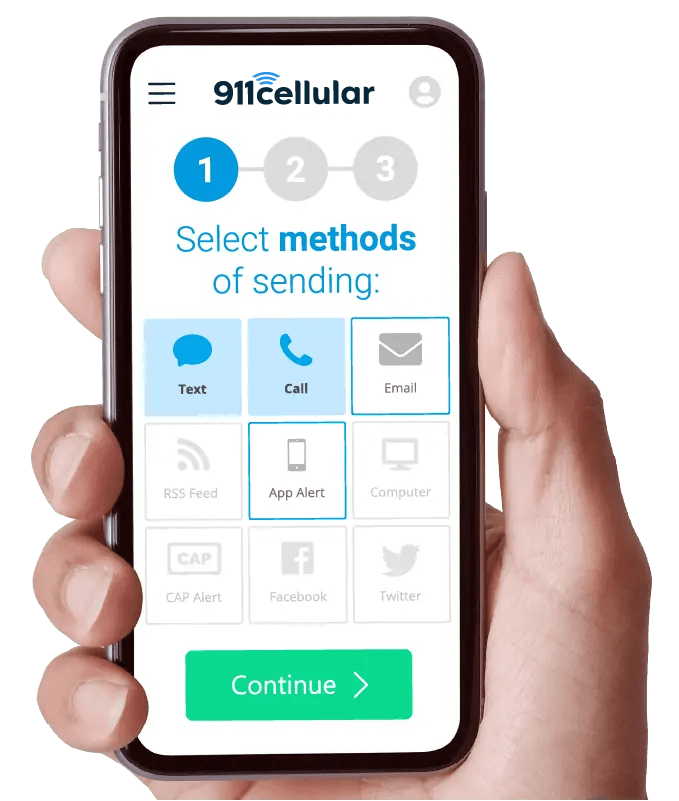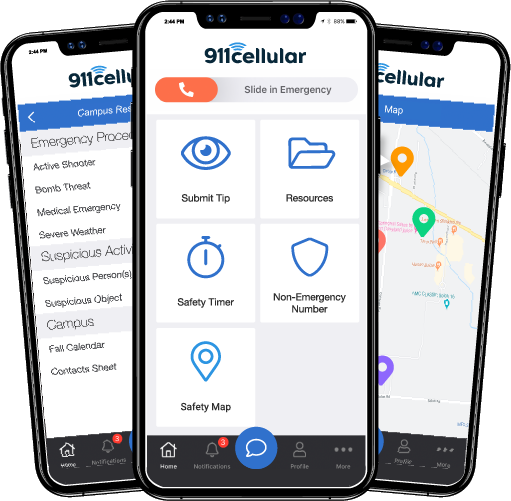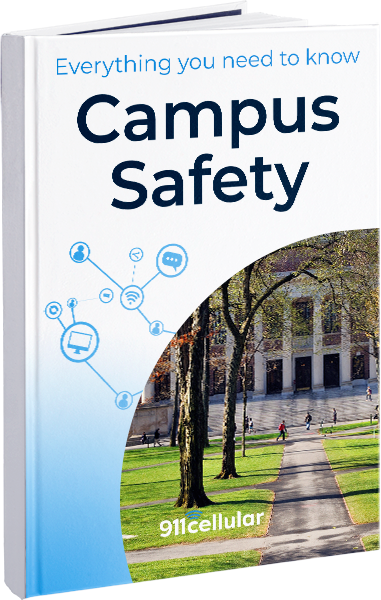Everything you need to know about campus safety
Introduction to campus safety
Campus safety is always a major consideration for campus authorities when creating and maintaining a healthy campus environment. Though many in the United States may think of colleges and universities when the word ‘campus’ comes to mind, in reality, campus environments can be found within hospital systems, businesses and K-12 school districts as well.
A campus is traditionally defined as a piece of land where a series of buildings (usually owned by one institution) combines with outdoor, recreational areas (like parks). The challenges related to keeping a campus safe are varied by the size and type of institution, but it’s no secret that campuses can be difficult to keep safe. With both indoor and outdoor spaces, along with potentially large, multi-story buildings, it would be impossible to constantly monitor every corner and dark pathway of any campus.
If residential areas are also a part of the campus jurisdiction (as is the case with many higher education institutions), it makes it that much more difficult to keep those residents secure. Burglaries, sexual harassment and motor vehicle thefts are some of the most commonly reported crimes on college campuses according to the U.S. Department of Education.
So what’s involved with keeping a campus safe? What does the current campus safety landscape look like and how is it evolving to meet both technological and social changes taking place in the 2020s and beyond?
To get a baseline for how we can dissect and evaluate campus safety as a whole, let’s start with legislation as a common ground.
Looking for campus safety solutions?Find yours today
Campus safety legislation
The Jeanne Clery Act
As it relates to the safety and security of college campuses, the federal government passed the most well-known campus safety bill in history in 1990. This famous bill is known as the Jeanne Clery Act. It was signed into law to help protect all federally funded college campuses by improving data tracking and transparency related to crimes on and around campus. The Clery Act also requires colleges to support victims of violence, outline procedures for security improvement, and inform campus community members in a timely manner when Clery-related incidents occur.
How the Clery Act came to be
Jeanne Clery was a student at Lehigh University in 1986 when she was raped and murdered in her college dormitory. Jeanne’s parents believed that the college failed to report unsettling crime trends in the time leading up to her death. In the years that followed, Connie and Howard Clery campaigned for legislation that would protect students to be implemented at all college campuses across the country.
In 1990, the Clery Act was officially signed into law, and has since been updated to include a variety of campus safety standards that must be met by every federally funded college in the United States.
How the Clery Act affects college campuses today
Violations of the Clery Act are well-known to be costly. In 2019, the Department of Education fined a major midwestern university over $4 million for “failure to protect students from sexual abuse”. The punishment goes beyond the cost of the fine as well. Students and parents are likely to reconsider their top post-secondary choices if a major Clery Act fine was just imposed.
With the threat of these penalties, colleges rarely tempt fate and instead dish out large sums of money beforehand to staff departments that meticulously follow the guidelines of the Clery Act and Title IX. These departments, along with others, are also tasked with implementing changes that will reduce their risk factors moving forward. Sometimes this comes in the form of a policy of workflow change, other times it can manifest as a technology purchase or other third-party assistance that also must be evaluated, vetted, approved and implemented.
This makes for a lot of moving parts in and around the campus safety space. And with the Clery Act becoming more comprehensive, this trend is likely to continue.
The requirements
The Clery Act requirements are extensive and can be grouped into five primary categories:
Annual Security Reporting (ASR) - Colleges are required to disseminate a public annual security report (ASR) to employees and students every October 1st. This ASR must include campus crime statistics for the preceding 3 calendar years, plus details about efforts taken to improve campus safety.
Crime Categories Covered - Within the ASR, colleges must include 4 distinct categories of crime: Criminal Offenses, Hate Crimes, Violence Against Women Act (VAWA) Offenses, and Arrests and Referrals for Disciplinary Action.
Crime Reporting Geography and Availability - Incidents that take place off campus property may still need to be reported if the safety of the campus community is still affected. Institutions must include statistics for crime that occur anywhere on campus, on-campus student housing, on public property within campus bounds, on public property immediately adjacent to the campus, and even on non-campus buildings and property owned by the college that are used for educational purposes and frequently used by students but not a part of the core campus (or those owned or controlled by a student organization officially recognized by the institution).
Timely Warnings and Emergency Notifications - When a crime covered by the Clery Act occurs, campus authorities are required to determine if there is a serious or ongoing threat to the campus community. If so, a timely warning must be issued to all staff and students. In the event of an immediate, significant danger to the health or safety of the campus community, campus officials may issue an emergency notification (to the entire campus or a specific, targeted group).
Victim Rights, Options, and Resources - Victims of sexual assault, domestic violence, dating violence, and stalking have specific rights, options, and resources guaranteed to them by the Clery Act. These include prevention education, student and employee rights, and disciplinary proceedings.
The government’s role in campus safety reform
Aside from the Clery Act, the federal government’s legislative reach is minimal as it relates to campus safety. At the federal level, the government is unlikely to provide sweeping, large-scale requirements that apply to all campuses of every size and within every state. Instead, they mostly defer to industry groups and state / local governments in order to create rules and regulations regarding campus safety in their respective regions.
Emergency notification compliance
To comply with the Clery Act, college campuses must have a mass notification system in place that can send out emergency alerts to the campus community in a timely manner. Most of these systems are developed by a third party vendor and are capable of sending to targeted groups.
Since the Clery Act became law in 1990, a lot has changed with communication technology. The internet is now our primary source of information gathering, smartphones are in everybody’s pocket, and a variety of digital devices are capable of receiving and displaying instant alerts.
The mass communication market is now capable of so much more than ever before… and it helps keep everybody in a campus environment secure because there is now more opportunity to deliver critical information to students, staff and employees regardless of where they happen to be at the time.
Some of the capabilities of today’s mass notification systems include:
Multimodal sending
Perhaps the most apparent mass notification need is to be able to send out a single message to multiple receiving platforms. These platforms will often include:
SMS (text message)
Phone call
Push notification (if you have a safety app)
RSS feed (post to website)
Social media (Twitter, Facebook)
CAP Alerts (loudspeakers, CCTVs, digital signage)
VOIP phones
Mobile sending and improved user experience
A potentially overlooked aspect of the mass notification process is the experience that the sender has before and during the sending process. It is equally important that the sender(s) have a high degree of confidence in the tool they’re using to send out the notification, which is where user experience (UX) design comes into play.
It’s one thing to create a software program capable of sending out alerts reliably on a mass scale, it’s another thing altogether to make that program a breeze to use without sacrificing features and customization options.
One way this is being done in the mass notification space is by providing a mobile app for senders. Mobile app development forces companies to consider the UX of their product in ways that software developed for a large monitor doesn’t. Mobile apps have to be simple in design yet still provide indications of additional options and features available.

An example of a mobile app designed to send mass notifications
Check-in requests
Innovation is on the horizon for some mass notification systems available today. And in some cases, innovative, yet reliable mass notification has already arrived. Certain systems allow for an extremely high level of data gathering that makes emergency managers everywhere breathe a sigh of relief.
In these unique systems, it’s possible to receive live updates regarding the location and safety status of the alert recipients.
Choosing your mass notification system
Because of the Clery Act, almost every college already has some kind of mass notification system in place. Evaluating its performance and cost-effectiveness may only be a task that comes around once every few years, depending on the length of the contract. If a mass notification system appears to be underutilized (too many features for real-world use), underperforming (reliability issues), or just costs too much when other options are available, then searching for a new system may be appropriate.
If your organization is looking to implement a new mass notification system, consider the factors mentioned in this section and how versatile the system is for continued usage over the term of the contract.
Remember that training and system usability may not initially seem as important as features are, but when a system is implemented, a poor user experience can render the software nearly useless. Try imagining how the system will work in your environment, how many people will need to be trained and what the overall usability will be like.
If you want to learn how mass notification got to this point and what mass communication methods were utilized historically, read this article: What’s next for mass notification systems?
Ensure your response protocols are in place
Maintaining your EAP
An emergency action plan (EAP) is vital for every organization, regardless of size or industry. Some businesses are required to have EAPs, but others are not mandated to do so. Lacking an updated EAP (or any EAP) can put any organization at risk of losing their entire business if an emergency situation were to arise. It’s estimated that up to 40% of businesses affected by natural or human-caused disasters never reopen.
An effective EAP will include a thorough breakdown of what is being done to pre-empt certain critical scenarios, how to deal with these scenarios, and how to carry out a response if this scenario were to happen. This can be quite a complicated task when you consider environmental factors, emergency response teams and communication.
After an EAP is complete, the work is not done. It’s imperative that your EAP is disseminated throughout your entire organization so every person has a leg up on what their role is during each possible scenario. Regular testing is also important. Your testing should take place during busy times to simulate your plan’s effectiveness in an environment that is as close as possible to a crisis. After testing is complete, you’ll get an idea of how your written plan stacks up to its real world application… and you can revise it accordingly.
EAPs are meant to be suited to your specific campus environment. Ultimately, it’s up to you to decide which scenarios to prepare for and how your community is fit to respond to them. But if you’re unsure where to start, here are some sections you might want to include in your EAP:
Emergency personnel names, phone numbers and other contact information
Evacuation routes and gathering points
Severe weather and natural disaster checklist
Medical emergency, extended power loss, structural emergencies
Campus violence protocol
Active shooter preparedness
Active shooter response
One of the unfortunate realities of today’s world is the surprising number of mass shootings that have taken place over the last couple of decades. Even more alarming perhaps, is that campuses are no stranger to this type of crisis.
Because of this, campuses without an active shooter response plan in place are putting themselves at risk.
The most popular, memorable phrase circulating in the active shooter response space is probably ‘Run, Hide, Fight’. You may have heard this simple piece of advice and have already implemented it into your EAP. But this catchy, helpful phrase may be a little more complicated than most initially thought.
Some experts suggest that the ‘Run, Hide, Fight’ mantra may confuse people into thinking that it is a sequential, step-by-step list of instructions (run first, then hide, then look to fight). This is not at all the case, and clarification needs to be given to those who may misunderstand the phrase in this way.
Also, ‘Run, Hide, Fight’ may be replaceable by other keywords that resonate more clearly with the masses and communicate more efficiently what most experts are trying to advise us to do in this terrible situation.
Avoid (Run)
The word ‘run’ implies that one should ‘make a break for it’, a ‘mad dash’ to the nearest exit. While this may work out for some who are close to clear exit points and away from the active shooter’s current location, it’s not always sound advice.
In fact, simply running toward a perceived exit point may prove deadly. The active shooter may see you while you’re running, plus running may make more noise and attract the shooter even if they don’t see you at first.
Perhaps a more relevant word would be ‘avoid’. Avoid the active shooter at all costs, if you believe an exit point is going to put you in danger, you probably shouldn’t run for it without at least scouting additional, potentially safer’ exit points that may be further away from the last known location of the shooter.
Deny (Hide)
If running, or avoiding the shooter is not possible, it’s time to try and hide from the shooter. Again, this is where some experts believe a new keyword may be more appropriate. The word ‘deny’ could work, because you would be essentially attempting to deny the shooter access into your space.
For instance, if you think leaving your office or classroom will put you in further harm, barricade the doorway(s), turn off the lights and silence your phone. Do everything possible to prevent the shooter from finding you or even knowing you exist in the first place.
Defend (Fight)
While you’re denying the shooter access to your space, you may need to be thinking about the next potential step, should you be located and targeted by them. This is the ‘fight’ or ‘defend’ stage. Obviously this is extremely risky, considering you are likely unarmed. This is definitely a last resort.
One thing to remember here is… do not fight fairly! Go for the soft spots (groin, eyes, throat) and be as aggressive and resourceful as possible during this stage. Use objects from your environment if you can.
This last resort action should only be initiated if you believe your life is hanging in the balance.
Your campus, your rules
Whether you decide to promote the ‘Run, Hide, Fight’ phrase… ‘Avoid, Deny, Defend’… or some other variation, make sure you and your emergency planning team are thinking about what the best possible set of instructions are for your campus community should you face an active shooter situation. And be sure to communicate this advice to your entire campus community at regular intervals throughout the year.
Securing campus grounds
After achieving Clery compliance and making sure your emergency planning is in place, when it comes to campus safety, perhaps the most obvious place to start implementing technology is on campus grounds. There may be a lot of ground to cover, depending on the size of your campus, but you may already have a head start…
Blue light phones
Blue light phones and their tall, towering frames are a classic symbol of campus safety that still stand today at colleges, hospitals, large businesses and school districts. These iconic blue towers have been a staple of campus security for decades. They became prominent in the 1990s and early 2000s in the years following the Clery Act’s initial legislation.
By 2005, over 90% of colleges and universities nationwide had installed blue light phones according to the Bureau of Justice Statistics.
Though the original devices may look similar to what you can find on campuses today, the technology has changed tremendously.
Originally, blue light towers were connected to a landline that was hard-wired directly to campus police or other local safety forces. Installation and maintenance of a single blue light tower could cost many thousands of dollars.
Blue light phones today
Today’s blue light systems are much more adaptable to the mobile age. Though the blue light tower itself may be stationary, it’s panic button technology can be developed to integrate with third party systems such as mobile safety apps. This widens the coverage area for campus safety capabilities, giving campuses both the recognizable crime deterrent that blue light phones provide while also reaching into the pockets of everyone with a smartphone who is passing by.
Newer blue light phone technology also takes advantage of solar power to decrease its carbon footprint and maintenance costs.
Despite these upgrades, some campuses see blue light phones as ineffective and expensive, opting to remove them to save money while replacing their safety function with less expensive software options.
Each campus is entirely unique, so it depends what is best for your campus community and physical environment if you’re considering blue light tower implementation or removal. Many campuses today successfully deploy a mixed approach with both blue light towers and mobile app solutions in place. This can be particularly effective when the two systems are capable of working together.
Learn more about blue lights to see if they’re right for your campus environment.
Implementing a campus safety app
Campus safety apps are a relatively new technology to the campus safety scene. When they first arrived in the early 2010s, there were fewer companies providing them and their lack of a track record made campuses hesitant to jump on board. Now, there are all kinds of safety apps to choose from and the technology is more refined, making campus safety apps an attractive option for protecting campuses everywhere.

Learn how to evaluate campus safety apps like a pro!Download FREE ebook
Not all safety apps are created equal, but most are versatile enough to allow for integration with other technologies (such as blue lights, security cameras and access control). They can also be very low-cost compared to other campus safety solutions, which makes them even more alluring to campus administrators.
If you’re thinking about implementing a campus safety app, or auditing your current one, there are a variety of evaluation points you should consider:
Features
Your safety app’s features will determine what it can actually do. Some apps have configuration controls that your campus administrators can access to edit these features (add, rearrange, edit names, remove). Either way, this list of features embodies what some of the premiere safety apps can provide.
Panic button
Panic buttons have changed over the years, but they still remain the staple of most campus safety app solutions. The technology behind panic buttons can seem rather simple… after activation, it calls and/or sends information to someone (or a group of someones). But despite its simple appearance, there’s a lot more to consider when we look under the hood.
How easy is it to activate the panic button? Within the app itself, a digital panic button can take many forms, but the key thing to look at with safety app panic buttons is whether or not they can be activated outside of the app. If an app can pull off this game changing functionality, it usually means the panic button can be accessed from the smartphone’s lock screen via widget.
This allows users to very quickly activate the panic button without needing to unlock their smartphone and sift through crowded home screens to find your safety app.
Where is the information going? So after the panic button is activated, who’s receiving the call? If your campus has a dedicated dispatch center, this may seem obvious… but not all campuses do. And even for campuses with dispatch centers, getting the call over to dispatch may only be the first step in providing the best possible response.
If your campus safety app can’t send panic button activation information to targeted groups, it may be time to upgrade. This essential feature puts potentially lifesaving information (including active location) in the hands of the people who are most capable of responding.
Depending on the location of the panic button activation, you can even select different response team members who are stationed in that area to receive that call (or text).
What’s involved with making this work? The great thing about all this is that there is panic button technology that does not require extensive set-up time or additional hardware purchases for advanced location tracking and communication to your team.
Unfortunately, some providers do their best to trick you into thinking these capabilities exist on their platform without disclosing the expensive details and complicated requirements needed to get everything up to speed (hidden fees, beacon installations). Make sure you ask questions about what else might be required for advanced panic button functionality! The last thing you want is to fast-track a safety app ‘solution’ that ends up pulling the bait-and-switch on you at the last minute.
‘See Something, Say Something’ capability
The popular ‘See Something, Say Something’ catchphrase has played a key role in campus safety initiatives since its mass adoption in the early 2000s. Perhaps the most proactive safety feature within campus safety apps takes advantage of this well-known movement by asking community members to use the app to submit tips.
Virtually every app will provide this feature in one way or another. Categories are usually selectable that identify the type of tip being submitted (which can send the tip to different places). Photos and videos are also encouraged to help the recipient of the tip understand the situation better.
With some safety apps, chat capabilities are also possible. This allows tip recipients to begin a dialogue to inquire more about the details of the tip.
Lastly, the option for app users to send their tip anonymously can be the difference between high and low submission rates. Particularly in higher education, students rarely choose to attach their identity to their tip. So make sure your campus safety app provides this option for users.
Additional features for safety and convenience
The features above may be the most popular and well-known to campus safety apps, but most available solutions will provide an additional set of features that further enhance the safety of your campus community members while also possibly adding some convenience for your organization as a whole.

Safety apps can offer multiple features beyond panic button functionality
Some additional features you might run into (or want to ask about) are described below:
Resource centers - Resource centers are essentially digital folders where you can drop files or link URLs. They come in handy because they can eliminate the need for expensive print-outs. Some resource centers can also notify users when updates are made.
Interactive map - Interactive maps are not simply pictures of your campus map (those can be linked to in the resource center). With interactive maps, campus administrators should be able to mark key locations with pins or other identifiers and attach relevant data. Examples of places you might want to identify for your campus community include:
- Fire extinguisher locations
- AED locations
- Clinics / medical assistance
- Campus security locations
- Bus stops
It doesn’t stop there, your campus is unique, so using this feature is a great opportunity to direct your campus community to resources that could help them when they’re in need.
Safety timer - Safety timers come in all shapes and sizes. Their names are usually varied as well, but the basic idea is to provide app users with a timer they can set when they may be engaging in riskier than normal activities (such as walking to their call late at night). This timer is tied in with emergency contacts they designate beforehand, and if the timer hits zero before they enter their PIN to deactivate it, their emergency contacts will be notified.
Customization
Safety app customization is extremely important for most campus communities because, particularly with students, branding is associated with pride and trust. If your campus safety app is generically branded, it will likely attract less attention and interest.
At a minimum, your campus safety app provider should let you change the look of the interface (colors, names). But you should also consider app providers that let you fully white label your app. This means you can change the name and icon as well. It will be a separate app that your community members can download from the App Store or Google Play.
Increasing awareness and usage
So here we are, the app has been chosen, you can brand it to match your organization’s brand standards… and so we’re all set and ready to go! Well… some believe that to be the case, but there’s one more crucial step… getting the word out.
Marketing your campus safety app might not be a major undertaking, but you at least need to consider possible preparations to get your community interested in putting this app on their phone (and actually using it).
If you’re a higher education institution, it all comes down to timing. Each year, you’ll have at least one orientation or ‘welcome week’ for new students. This is the perfect time to unleash your marketing strategy (you may need to build up your strategy weeks or months in advance). Here are some tips to get you started:
Partner up
Get others involved. Meet with your social media managers, student government leaders, professors and other campus outreach personnel to identify an effective and efficient strategy for reach-out. It may end up being less work than it seems if the right people are on board.
Utilize your existing app(s)
If your campus already has an app (like one for scheduling courses), you may already have the best marketing tool on the horizon. You’ll just have to speak with your IT department, or whoever is in charge of the app’s development. When they’re on board, a simple snippet of code will then display your campus safety app within the widely used campus app. It’s that simple!

How do you increase student engagement with your campus safety app?Download FREE ebook
More ways to improve safety on campus
Safety apps and blue lights may be two of the most popular and well-known campus safety technologies, but there are a host of other solutions, both old and new, that can contribute to a more secure campus environment.
Lighting and surveillance
When street lights became popular in the early 20th century, they came with a number of different benefits. They helped to reduce vehicle accidents (especially vehicles hitting pedestrians) while also deterring crime. This study highlights the advantages of illuminating communities to protect them.
Surveillance equipment can do the same to deter crime. Advertising your camera system (even if you exaggerate its reach) does well to protect your campus.
Software panic buttons for your computers
Whether or not you have a campus safety app implemented, utilizing software panic buttons for your desktops, laptops and tablets may still be beneficial. Computer panic buttons are known for being discrete and easily accessible for those who use a computer at work.
Historically, these buttons were physically installed, and therefore very expensive to implement and maintain. If you wanted to protect your campus or business with hard-wired (bank-style) computer panic buttons, it was going to cost you, and you would likely have to choose a small percentage of your institution to cover as a result.
Today, software panic buttons allow for complete campus coverage without the antiquated hard-wired system. Remote installation, configuration and testing can be conducted in a fraction of the time and it has become an affordable option for any size organization.
These software panic buttons are also extremely flexible, meaning you can install them on your desktops, laptops and tablets. If a laptop or tablet panic button is activated, location information can be sent to the proper authorities even if the person is on the move.
Train your campus community
Perhaps the best tool for a safe campus environment is the education of the campus community. In a college campus setting, students will always engage in a certain amount of risky behaviour. But the school has a responsibility to educate its students, to the best of their ability, on the dangers of certain activities and how to reduce their risk of being a victim of crime.
Make sure to at least consider training your campus community on the following topics:
How to protect your belongings
Basic self-defense
Basic first aid training
Alcohol and drug awareness
These are just a few examples on how to train people to protect themselves. Make sure to do what’s best for your campus when evaluating your training plan.

Take this guide with you!
Want to access this information anytime? Download the free PDF of Everything you need to know about campus safety.

